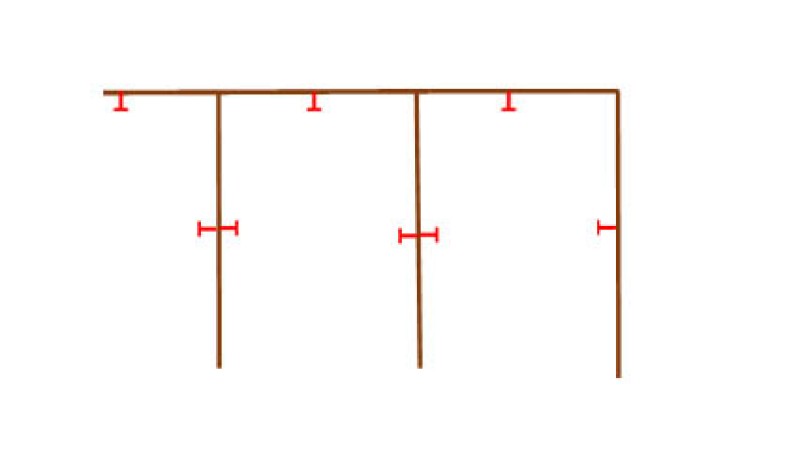You are here: Exploring the Boundaries of Fences
As time passes, boundaries between properties can become blurred as hedges get planted, grow into neighbouring gardens, then get taken down and replaced by walls or fences or other hedges. Ownership or responsibility for care and maintenance of boundaries can also become a bone of contention between neighbours, especially when they are in need of replacement or repair which has a cost attached.
Title Registers and Title Plans are the two main title documents of land and property, although it is recognised that in England and Wales, neither of these documents will give you an accurate, definitive border line between properties. They will give an approximate boundary but no more, nor will they apportion responsibility for ownership of hedges or trees on the approximate boundary between properties.
The easiest way to determine an exact boundary is to have a conversation with your neighbour and agree informally what you will treat as the boundary, for all practical purposes. To get a precise boundary line registered on the title of your property, you can either make and register a boundary agreement with your neighbour or apply to the Land Registry for a determined boundary.
With a boundary agreement, as the name suggests, you would agree the exact boundary with your neighbour and either draw a map or mark the boundary on a large scale ordinance survey map. At this stage it is wise to seek advice from a solicitor in drawing up a written agreement. The document should include the date of the agreement, the two parties making the agreement and their respective land title numbers and along with the map, should be submitted to the Land Register.
Applying to the Land Registry for a determined boundary involves having a surveyor decide your boundary and drawing a map, which your neighbour would have the opportunity to agree to, then sending your application along with the appropriate package of information to the Land Registry. If your neighbour agrees with your application, the boundary will be amended accordingly. If you and your neighbour cannot reach an agreement, your application would go to a tribunal which will make a ruling.
It is worth bearing in mind that to undertake any of the above, your property must first be registered on the HM Land Registry. This may not be the case unless the property has changed ownership or has been mortgaged after 1990.
Having ascertained and agreed where the boundaries between properties are, the next question is “Who is responsible for hedges, fences or walls?” People often think they are responsible for the left (or right) hand boundary of their property, but there is no legal basis for this.
On some Title Plans, the boundary fences or walls are marked with a red T, (often referred to as a T-Mark), as in Fig1. A single T on one side, denotes the ownership and the responsibility for the maintenance of the fence or wall. A T on both sides, forming an H (or H-Mark) denotes a party wall or fence.

Fig 1.
It is possible when agreeing a boundary with your neighbour, to add this detail onto the Title Plans, for the avoidance of any future doubt. Not all Title Plans include this detail, so it then become the responsibility of the property owners to decide who owns what. As mentioned earlier, the old adage which states that you own the fence or wall on the left of your property has no legal bearing, but it is normally reasonable to expect that the fence posts should be in the owner’s garden, with the face on the neighbour’s side, if that configuration has been used, as opposed to central posts.
Repair or replacement of boundary walls or fences are another issue which raises questions and sometimes arguments between neighbours, particularly with fences as they tend to be more fragile that a wall.
If you, or your neighbour, own a fence which is badly in need of repair or replacement, there is no legal obligation on either of you to carry out the work, as there is no legal requirement for a fence there in the first place. If your neighbour’s fence is falling down, you have no right to repair it, no matter how much of an eye-sore it is, without getting permission from that neighbour. If an old, crumbling fence is an annoyance to you, you are quite at liberty to build another fence alongside your neighbour’s, on your ground.
There are also regulations and restrictions attached to erecting a new fence and these can vary from one local authority to another. Usually, however, the highest fence allowed without planning permission is two metres in height, over two metres, planning permission must be sought. This height restriction will drop to one metre where a property borders a public road or is in a conservation area. As with any restrictions which involve planning permissions, it is better to check with the local authority planning office before proceeding.
Professional advice and help will eventually become necessary to finalise any matters pertaining to title deeds but it is sometimes worth bearing in mind that often the quickest and easiest way to settle a dispute, is to talk to the other party. If a boundary issue become a problem, before you call in the professionals, talk to your neighbour. Let’s face it, you live just over the fence.
If you are thinking of buying or selling your home, you may find some of these services useful:
Conveyancing
Get instant estimates from Conveyancers and Solicitors in your local area
Mortgage Brokers
I need help getting a mortgage
Estate Agent
Find a local Estate Agent
Valuation Surveys
If you need a Valuation Survey
Building Surveys
I want a local surveyor to do a Building Survey for me
Removals
I want to find a removal company
Energy Performance Certificate
Energy Performance Certificates